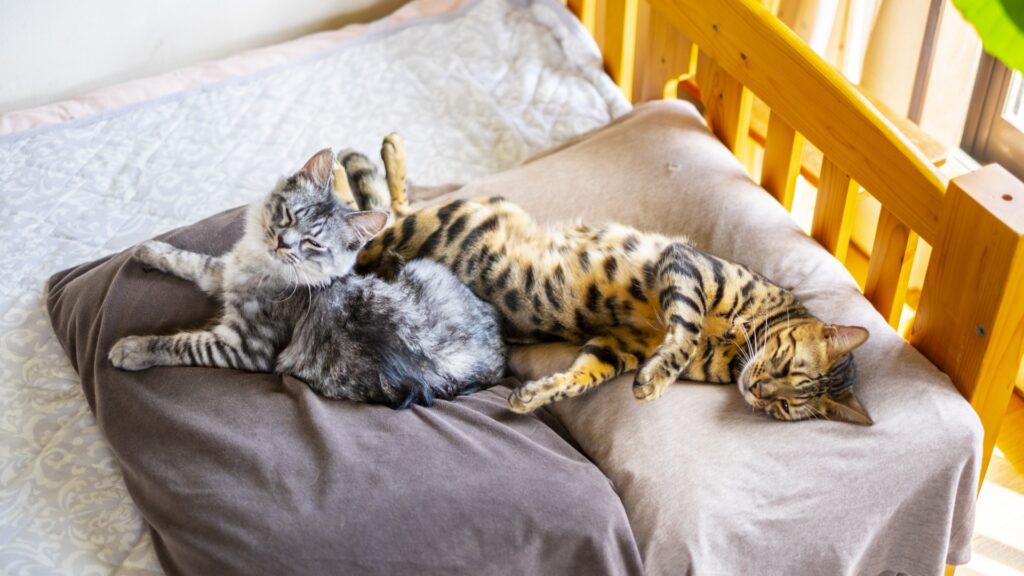How to Tell When Your Cat is Happy: A Guide for Cat Owners
Introduction
Cats have a reputation for being enigmatic and independent creatures, which can make it challenging for owners to interpret their emotions. However, cats do show signs of happiness and contentment in their own unique ways. Understanding these signals can help strengthen the bond between you and your feline friend and ensure their well-being. This article will guide you through the various ways cats express their happiness and how you can recognize these signs.

Body Language
- Purring: One of the most well-known signs of a happy cat is purring. While cats can purr for various reasons, a steady, rhythmic purr usually indicates contentment and pleasure.
- Relaxed Posture: A happy cat will often display a relaxed and loose body posture. They may lie on their back with their belly exposed, stretch out their legs, or curl up in a cozy position.
- Tail Position: The position of a cat’s tail can reveal much about their mood. A happy cat’s tail will often be upright with a slight curve at the top, resembling a question mark. A gently swaying or twitching tail can also indicate contentment.
- Kneading: When a cat rhythmically presses its paws against a soft surface, this is called kneading. This behavior, often accompanied by purring, usually signifies that your cat is happy and comfortable.
- Slow Blinking: Cats communicate trust and affection through slow blinking. If your cat looks at you and slowly blinks, it’s a sign that they feel safe and happy in your presence. You can even reciprocate the slow blink to show your affection.
- Ears and Eyes: A content cat will have relaxed ears and eyes. The ears will be facing forward or slightly to the side, and the eyes will appear half-closed or gently blinking.
Vocalization
- Chirping and Trilling: Besides purring, happy cats may make chirping or trilling sounds. These sounds are often used by cats to communicate with their owners and can indicate excitement or a desire to engage.
- Meowing: While excessive meowing can sometimes indicate stress or a health issue, occasional, soft meows are a sign that your cat is in a good mood and wants to interact with you.
Social Behavior
- Head Butting and Cheek Rubbing: When a cat rubs its head or cheeks against you, it’s marking you with its scent, a sign of affection and contentment. This behavior is called bunting and indicates that your cat feels secure and happy around you.
- Following You: If your cat follows you around the house, it’s a sign that they enjoy your company and want to be near you. This behavior shows that they feel comfortable and secure in your presence.
- Playfulness: Happy cats are playful cats. If your cat regularly engages in play, whether it’s chasing toys, pouncing on invisible prey, or playing with you, it’s a clear sign they are happy and content.
Grooming
- Self-Grooming: Cats take pride in their grooming. A cat that spends time grooming itself is usually a happy and healthy cat. Lack of grooming can be a sign of stress or illness.
- Grooming You: When a cat licks you, it’s a sign of affection and trust. This grooming behavior indicates that your cat sees you as part of its social group.
Appetite and Eating Habits
- Healthy Appetite: A happy cat will have a good appetite and show enthusiasm during mealtime. Changes in appetite can indicate stress or health issues, so a consistent eating pattern is a good sign of contentment.
- Eating Together: Some cats enjoy eating in the presence of their owners. If your cat likes to eat while you’re nearby, it’s a sign that they feel safe and happy.
Sleeping Behavior
- Positions: Cats that sleep in relaxed positions, such as on their backs or sides, with their paws tucked in or stretched out, are typically content.
- Locations: Happy cats often choose to sleep in places where they feel safe and comfortable. If your cat chooses to sleep near you, it’s a sign of trust and affection.
Health and Maintenance
- Regular Vet Check-Ups: Regular health check-ups ensure that your cat is in good physical condition, which contributes to their overall happiness. A healthy cat is more likely to be a happy cat.
- Mental Stimulation: Providing your cat with mental and physical stimulation, such as interactive toys, climbing structures, and opportunities for exploration, can keep them happy and engaged.
CatsMe! is a revolutionary AI that makes it easy to detect such pain in cats by only uploading cat pictures.
Conclusion
Understanding your cat’s signs of happiness can enhance your relationship and ensure their well-being. By observing their body language, vocalizations, social behaviors, grooming habits, appetite, and sleeping patterns, you can gauge their mood and make any necessary adjustments to their environment or routine. A happy cat is a sign of a loving and attentive owner. By providing a safe, stimulating, and affectionate home, you can ensure that your feline companion remains content and healthy. If you ever notice significant changes in your cat’s behavior or signs of distress, consult your veterinarian for guidance.


